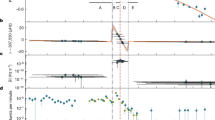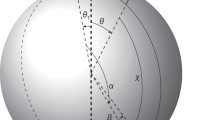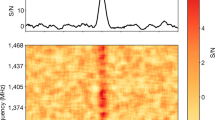Abstract
Magnetars are a special subset of the isolated neutron star family, with X-ray and radio emission mainly powered by the decay of their immense magnetic fields. Many attributes of magnetars remain poorly understood: spin-down glitches or the sudden reductions in the star’s angular momentum, radio bursts reminiscent of extragalactic fast radio bursts (FRBs) and transient pulsed radio emission lasting months to years. Here we unveil the detection of a large spin-down glitch event (fractional change in spin frequency \(| {{\Delta }}\nu /\nu | =5.{8}_{-1.6}^{+2.6}\times 1{0}^{-6}\)) from the magnetar SGR 1935+2154 on 5 October 2020 (±1 day). We find no change to the source-persistent surface thermal or magnetospheric X-ray behaviour, nor is there evidence of strong X-ray bursting activity. Yet, in the subsequent days, the magnetar emitted three FRB-like radio bursts followed by a month-long episode of pulsed radio emission. Given the rarity of spin-down glitches and radio signals from magnetars, their approximate synchronicity suggests an association, providing pivotal clues to their origin and triggering mechanisms with ramifications to the broader magnetar and FRB populations. We postulate that impulsive crustal plasma shedding close to the magnetic pole generates a wind that combs out magnetic field lines, rapidly reducing the star’s angular momentum while temporarily altering the magnetospheric field geometry to permit the pair creation needed to precipitate radio emission.
This is a preview of subscription content, access via your institution
Access options
Access Nature and 54 other Nature Portfolio journals
Get Nature+, our best-value online-access subscription
$29.99 / 30 days
cancel any time
Subscribe to this journal
Receive 12 digital issues and online access to articles
$119.00 per year
only $9.92 per issue
Buy this article
- Purchase on Springer Link
- Instant access to full article PDF
Prices may be subject to local taxes which are calculated during checkout







Similar content being viewed by others
Data availability
NICER raw data (level 1) and calibrated (level 2) data files were generated at the Goddard Space Flight Center large-scale facility. These data files are publicly available and can be found at https://heasarc.gsfc.nasa.gov/FTP/nicer/data/obs/. XMM-Newton and NuSTAR data files are also publicly available from the XMM-Newton Science Archive (https://heasarc.gsfc.nasa.gov/W3Browse/xmm-newton/xmmmaster.html) and the NuSTAR Master Catalog table (https://heasarc.gsfc.nasa.gov/W3Browse/all/numaster.html). Light curve and spectral data presented in the various plots of the manuscript are available from the corresponding authors upon request.
Code availability
Reduction and analysis of the data were conducted using publicly available codes provided by HEASARC, which is a service of the Astrophysics Science Division at NASA/GSFC and the High Energy Astrophysics Division of the Smithsonian Astrophysical Observatory. For NICER and NuSTAR, we used NICERDAS version v.008c and NUSTARDAS version v.2.1.1, respectively, part of HEASOFT 6.29c (https://heasarc.gsfc.nasa.gov/docs/software/lheasoft). For XMM-Newton, we utilize the publicly available SAS version 19.1.0. Spectral analysis was conducted using Xspec version 12.12.0g (https://heasarc.gsfc.nasa.gov/docs/xanadu/xspec/). The emcee MCMC sampler is a public software available at https://emcee.readthedocs.io/en/stable/. Custom codes for the timing analysis routines are available upon reasonable request from the corresponding authors.
References
Israel, G. L. et al. The discovery, monitoring and environment of SGR J1935+2154. Mon. Not. R. Astron. Soc. 457, 3448–3456 (2016).
Younes, G. et al. X-ray and radio observations of the magnetar SGR J1935+2154 during its 2014, 2015, and 2016 outbursts. Astrophys. J. 847, 85 (2017).
Younes, G. et al. NICER view of the 2020 burst storm and persistent emission of SGR 1935+2154. Astrophys. J. Lett. 904, L21 (2020).
Petroff, E., Hessels, J. W. T. & Lorimer, D. R. Fast radio bursts. Astron. Astrophys. Rev. 27, 4 (2019).
Bochenek, C. D. et al. A fast radio burst associated with a Galactic magnetar. Nature 587, 59–62 (2020).
CHIME/FRB Collaboration A bright millisecond-duration radio burst from a Galactic magnetar. Nature 587, 54–58 (2020).
Archibald, R. F. et al. An anti-glitch in a magnetar. Nature 497, 591–593 (2013).
Younes, G. et al. A radiatively quiet glitch and anti-glitch in the magnetar 1E 2259+586. Astrophys. J. Lett. 896, L42 (2020).
Dib, R. & Kaspi, V. M. 16 yr of RXTE monitoring of five anomalous X-ray pulsars. Astrophys. J. 784, 37 (2014).
Woods, P. M. et al. Variable spin-down in the soft gamma repeater SGR 1900+14 and correlations with burst activity. Astrophys. J. Lett. 524, L55–L58 (1999).
Good, D. & CHIME/FRB Collaboration CHIME/FRB detection of three more radio bursts from SGR 1935+2154. Astron. Telegr. 14074, 1 (2020).
Kirsten, F. et al. Detection of two bright radio bursts from magnetar SGR 1935+2154. Nat. Astron. 5, 414–422 (2020).
Zhu, W. et al. FAST detection of radio bursts and pulsed emission from SGR J1935+2154. Astron. Telegr. 14084, 1 (2020).
Lin, L. et al. No pulsed radio emission during a bursting phase of a Galactic magnetar. Nature 587, 63–65 (2020).
Parfrey, K., Beloborodov, A. M. & Hui, L. Twisting, reconnecting magnetospheres and magnetar spindown. Astrophys. J. Lett. 754, L12 (2012).
Mastrano, A., Suvorov, A. G. & Melatos, A. Interpreting the AXP 1E 2259+586 antiglitch as a change in internal magnetization. Mon. Not. R. Astron. Soc. 453, 522–530 (2015).
Thompson, C. et al. Physical mechanisms for the variable spin-down and light curve of SGR 1900+14. Astrophys. J. 543, 340–350 (2000).
Harding, A. K., Contopoulos, I. & Kazanas, D. Magnetar spin-down. Astrophys. J. Lett. 525, L125–L128 (1999).
Sturrock, P. A. A model of pulsars. Astrophys. J. 164, 529–556 (1971).
Wadiasingh, Z. et al. The fast radio burst luminosity function and death line in the low-twist magnetar model. Astrophys. J. 891, 82 (2020).
Bai, X.-N. & Spitkovsky, A. Modeling of gamma-ray pulsar light curves using the force-free magnetic field. Astrophys. J. 715, 1282–1301 (2010).
Kalapotharakos, C., Kazanas, D., Harding, A. & Contopoulos, I. Toward a realistic pulsar magnetosphere. Astrophys. J. 749, 2 (2012).
Harding, A. K., Tademaru, E. & Esposito, L. W. A curvature–radiation–pair-production model for gamma-ray pulsars. Astrophys. J. 225, 226–236 (1978).
Baring, M. G. & Harding, A. K. Photon splitting and pair creation in highly magnetized pulsars. Astrophys. J. 547, 929–948 (2001).
Baring, M. G. & Harding, A. K. Radio-quiet pulsars with ultrastrong magnetic fields. Astrophys. J. Lett. 507, L55–L58 (1998).
Beloborodov, A. M. & Li, X. Magnetar heating. Astrophys. J. 833, 261 (2016).
Metzger, B. D., Margalit, B. & Sironi, L. Fast radio bursts as synchrotron maser emission from decelerating relativistic blast waves. Mon. Not. R. Astron. Soc. 485, 4091–4106 (2019).
Ruderman, M. A. & Sutherland, P. G. Theory of pulsars: polar gaps, sparks, and coherent microwave radiation. Astrophys. J. 196, 51–72 (1975).
Gendreau, K. C. et al. The Neutron star Interior Composition Explorer (NICER): design and development. Proc. SPIE 9905, 99051H (2016).
Remillard, R. A. et al. An empirical background model for the NICER X-ray timing instrument. Astron. J. 163, 130 (2022).
Strüder, L. et al. The European Photon Imaging Camera on XMM-Newton: the pn-CCD camera. Astron. Astrophys. 365, L18–L26 (2001).
Harrison, F. A. et al. The Nuclear Spectroscopic Telescope Array (NuSTAR) high-energy X-ray mission. Astrophys. J. 770, 103 (2013).
Levan, A., Kouveliotou, C. & Fruchter, A. Identification of the infrared counterpart of SGR 1935+2154 with the Hubble Space Telescope. Astrophys. J. 854, 161 (2018).
Buccheri, R. et al. Search for pulsed gamma-ray emission from radio pulsars in the COS-B data. Astron. Astrophys. 128, 245–251 (1983).
Ray, P. S. et al. Precise γ-ray timing and radio observations of 17 Fermi γ-ray pulsars. Astrophys. J. Suppl. 194, 17 (2011).
Livingstone, M. A. et al. X-ray and radio timing of the pulsar in 3C 58. Astrophys. J. 706, 1163–1173 (2009).
Foreman-Mackey, D., Hogg, D. W., Lang, D. & Goodman, J. emcee: the MCMC hammer. Publ. Astron. Soc. Pac. 125, 306–312 (2013).
Archibald, R. F., Scholz, P., Kaspi, V. M., Tendulkar, S. P. & Beardmore, A. P. Two new outbursts and transient hard X-rays from 1E 1048.1-5937. Astrophys. J. 889, 160 (2020).
Hu, C.-P. et al. NICER observation of the temporal and spectral evolution of Swift J1818.0-1607: a missing link between magnetars and rotation-powered pulsars. Astrophys. J. 902, 1 (2020).
Woods, P. M. et al. Changes in the X-ray emission from the magnetar candidate 1E 2259+586 during its 2002 outburst. Astrophys. J. 605, 378–399 (2004).
Gavriil, F. P., Kaspi, V. M. & Woods, P. M. A comprehensive study of the X-ray bursts from the magnetar candidate 1E 2259+586. Astrophys. J. 607, 959–969 (2004).
Zhong, S.-Q., Dai, Z.-G., Zhang, H.-M. & Deng, C.-M. On the distance of SGR 1935+2154 associated with FRB 200428 and hosted in SNR G57.2+0.8. Astrophys. J. Lett. 898, L5 (2020).
Bailes, M. et al. Multifrequency observations of SGR J1935+2154. Mon. Not. R. Astron. Soc. 503, 5367–5384 (2021).
Borghese, A. et al. The first 7 months of the 2020 X-ray outburst of the magnetar SGR J1935+2154. Mon. Not. R. Astron. Soc. 516, 602–616 (2022).
Blaskiewicz, M., Cordes, J. M. & Wasserman, I. A relativistic model of pulsar polarization. Astrophys. J. 370, 643–669 (1991).
Dyks, J., Rudak, B. & Harding, A. K. On the methods of determining the radio emission geometry in pulsar magnetospheres. Astrophys. J. 607, 939–948 (2004).
Daugherty, J. K. & Harding, A. K. Electromagnetic cascades in pulsars. Astrophys. J. 252, 337–347 (1982).
Hu, K., Baring, M. G., Wadiasingh, Z. & Harding, A. K. Opacities for photon splitting and pair creation in neutron star magnetospheres. Mon. Not. R. Astron. Soc. 486, 3327–3349 (2019).
Tchekhovskoy, A., Philippov, A. & Spitkovsky, A. Three-dimensional analytical description of magnetized winds from oblique pulsars. Mon. Not. R. Astron. Soc. 457, 3384–3395 (2016).
Thompson, C., Lyutikov, M. & Kulkarni, S. R. Electrodynamics of magnetars: implications for the persistent X-ray emission and spin-down of the soft gamma repeaters and anomalous X-ray pulsars. Astrophys. J. 574, 332–355 (2002).
Hu, K., Baring, M. G., Harding, A. K. & Wadiasingh, Z. High-energy photon opacity in the twisted magnetospheres of magnetars. Astrophys. J. 940, 91 (2022).
Beloborodov, A. M. Untwisting magnetospheres of neutron stars. Astrophys. J. 703, 1044–1060 (2009).
Weisskopf, M. C. et al. The Imaging X-Ray Polarimetry Explorer (IXPE): pre-launch. J. Astron. Telesc. Instrum. Syst. 8, 026002 (2022).
Gaensler, B. M. et al. An expanding radio nebula produced by a giant flare from the magnetar SGR 1806-20. Nature 434, 1104–1106 (2005).
Ioka, K. Fast radio burst breakouts from magnetar burst fireballs. Astrophys. J. Lett. 904, L15 (2020).
Younes, G. et al. Broadband X-ray burst spectroscopy of the fast-radio-burst-emitting Galactic magnetar. Nat. Astron. 5, 408–413 (2021).
Acknowledgements
A portion of this work was supported by NASA through the NICER mission and the Astrophysics Explorers Program. This research has made use of data and software provided by the High Energy Astrophysics Science Archive Research Center (HEASARC), which is a service of the Astrophysics Science Division at NASA/GSFC and the High Energy Astrophysics Division of the Smithsonian Astrophysical Observatory. G.Y.’s research is supported by an appointment to the NASA Postdoctoral Program at the Goddard Space Flight Center, administered by Oak Ridge Associated Universities under contract with NASA. M.G.B. acknowledges the support of the National Science Foundation through grant AST-1813649. A.B.P. is a McGill Space Institute (MSI) Fellow and a Fonds de Recherche du Quebec–Nature et Technologies (FRQNT) postdoctoral fellow. S.G. acknowledges the support of the Centre National d’Etudes Spatiales (CNES). T.E. acknowledges Hakubi projects of Kyoto University and RIKEN, and is supported by JSPS/ MEXT KAKENHI grant numbers 15H00845 and 17K18776. W.C.G.H. acknowledges support through grant 80NSSC22K0397 from NASA. A.B. is supported by a Juan de la Cierva fellowship. C.-P.H. acknowledges support from the Ministry of Science and Technology in Taiwan through grant MOST 109-2112-M-018-009-MY3. W.A.M acknowledges support from the Jet Propulsion Laboratory, California Institute of Technology, under a Research and Technology Development Grant through a contract with NASA. US government sponsorship is acknowledged. G.Y. thanks V. Kaspi and T. Strohmayer for providing constructive comments on the manuscript and P. Ray for guidance on the timing analysis.
Author information
Authors and Affiliations
Contributions
G.Y. performed the data analysis and contributed to the writing of the associated text. M.G.B. led the interpretative elements and was responsible for the writing of the associated text. A.K.H., T.E., Z.W., W.C.G.H., S.G., A.B., A.B.P., T.G., A.J.v.d.H., C.-P.H., E.G., G.K.J., C.K., L.L. and W.A.M. contributed to the discussion and editing of the manuscript. A.B.P. and G.Y. were responsible for acquiring the majority of the NICER data through the Director’s Discretionary Time. E.G. and L.L. were responsible for acquiring part of the XMM-Newton and NuSTAR data. A.B. was responsible for acquiring the XMM-Newton October 1 data and part of the NICER data. K.G. is the NICER principal investigator; he approved the Director’s Discretionary Time observations. Z.A. is the NICER project scientist and deputy principal investigator; he contributed to the scheduling of the NICER observations.
Corresponding authors
Ethics declarations
Competing interests
The authors declare no competing interests.
Peer review
Peer review information
Nature Astronomy thanks Shriharsh Tendulkar and the other, anonymous, reviewer(s) for their contribution to the peer review of this work.
Additional information
Publisher’s note Springer Nature remains neutral with regard to jurisdictional claims in published maps and institutional affiliations.
Supplementary information
Supplementary Information
Supplementary Fig. 1 and Tables 1 and 2.
Rights and permissions
Springer Nature or its licensor (e.g. a society or other partner) holds exclusive rights to this article under a publishing agreement with the author(s) or other rightsholder(s); author self-archiving of the accepted manuscript version of this article is solely governed by the terms of such publishing agreement and applicable law.
About this article
Cite this article
Younes, G., Baring, M.G., Harding, A.K. et al. Magnetar spin-down glitch clearing the way for FRB-like bursts and a pulsed radio episode. Nat Astron 7, 339–350 (2023). https://doi.org/10.1038/s41550-022-01865-y
Received:
Accepted:
Published:
Issue Date:
DOI: https://doi.org/10.1038/s41550-022-01865-y
This article is cited by
-
Rapid spin changes around a magnetar fast radio burst
Nature (2024)



